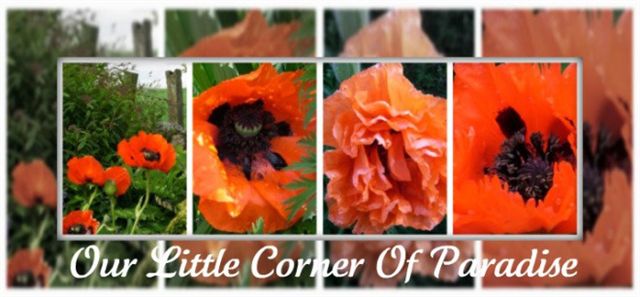



 During our second Summer in the village, when our younger son was still chief lunch-maker and I had resumed the mantle of head gardener, my husband decided that he would begin the marathon chore of tackling the rust on the corrugated tin roof of the barn before actually painting it.
During our second Summer in the village, when our younger son was still chief lunch-maker and I had resumed the mantle of head gardener, my husband decided that he would begin the marathon chore of tackling the rust on the corrugated tin roof of the barn before actually painting it.The area of the roof is 1700 square feet, and being at a high-pitched angle, it was necessary to invest in an extension hook ladder, which could be fastened securely to the ridge in the interests of safety, while also allowing for flexibility in movement when the ladder needed to be shifted to a new position.
Wire brush in hand, safety goggles at the ready, my husband climbed the ladder to begin the onerous task of scraping off years of rust. After an hour or two of tiring work, during which time he had been trying to avoid inhaling the rust, he was glad to take a break while our elder son offered to take over.
This pattern of sharing out the workload continued throughout the Summer. At the end of each day, not only were their clothes covered in rust but it also found its way into their hair, ears, nose and eyes, to the extent that they could have been mistaken for coal miners.
No sooner had they completed the time-consuming job of removing the rust from both sides of the roof, when they went all the way back to the beginning again to do the actual painting. Though it is fair to say the whole process had entailed hard graft, as many worthwhile jobs often do, their spirit of cooperation had created yet another bond between father and son.

I love the Ivy all over the wall, it looks gorgeous!
ReplyDeleteThank you for your comment, Thalia. We have over 300 sparrows which roost in it every night! And some nest there too along with starlings, a blackbird and a wren.
ReplyDeleteGreat blog. I will be back so vist this one. I love the pictures. If you love wildflowers you need to have some butterfly weeds in your garden.
ReplyDeleteThank you for stopping by, Greg, and for your very encouraging words too. Our garden, being a cottage garden, is made up mainly of nectar-rich borders for butterflies, moths, damselflies, dragonflies, mayflies, hoverflies, and bees.
ReplyDeleteVery beautiful and charmed. I have a friend originally from Sterling, who now lives in France, in a farmhouse she and her boyfriend restored themselves. These pics and your post reminds me of her garden.
ReplyDeleteThat's a great barn! And a nice garden space too. We have a simple, newer barn because the people who lived here before us had alpacas. The barn was always open so swallows moved in. No more animals, extra bugs, and open barn, the swallows moved on. I do see evidence that some bird is using an old swallow nest in a covered, outside stall attached to the barn (my outdoor potting area). I really hope a swallow will return to this area.
ReplyDeleteThank you for visiting my blog, Nicole, and for your gracious comment about the barn. Three stray cats live in it and in the summer we have swallows nesting in the rafters.
ReplyDeleteI do hope you get a swallow in your barn, Petunia's Gardener. What about Petunia snake though? Could it reach the nest if a swallow came, or is it a grass snake? Alpacas sound very exotic to me, here in Scotland, where I keep two cats and look after the three strays. Sometimes we have starlings stealing the swallows' nests from previous years. Thanks for stopping by. I'll keep up with your blog to see if you get that swallow.